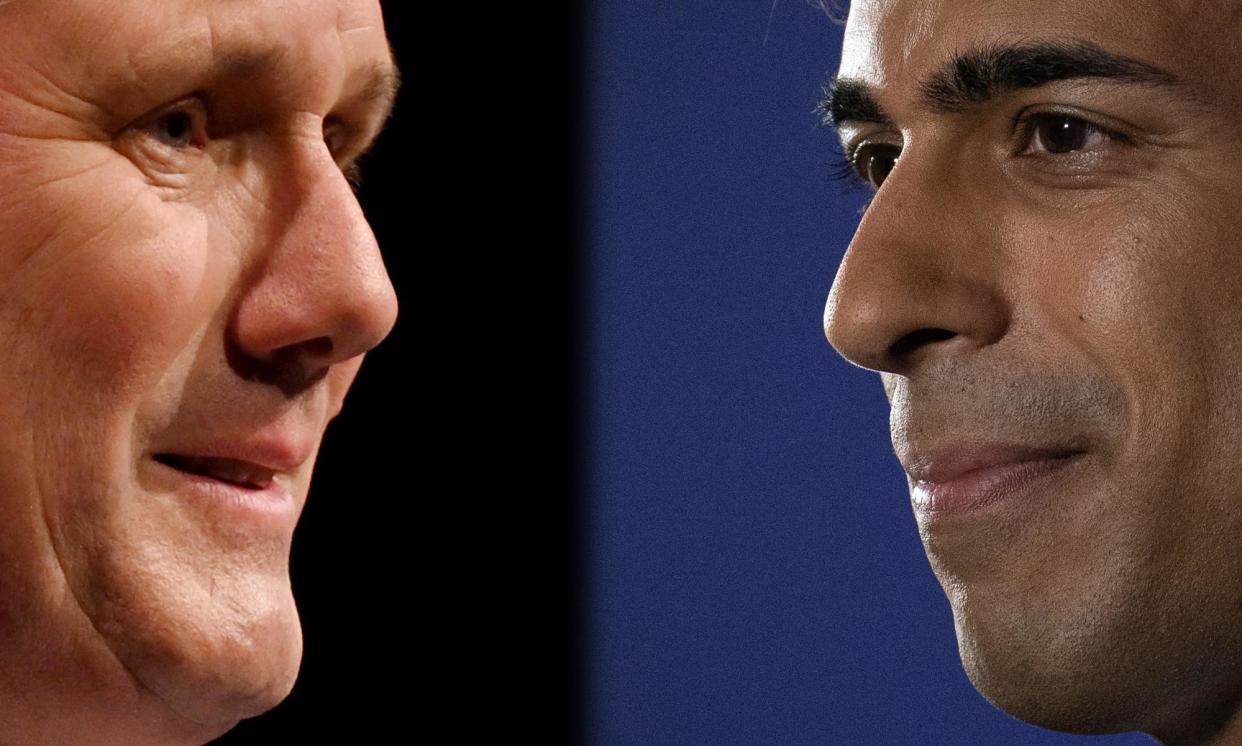From first impressions to tactical voting: how the UK election will be won or lost

Here we go again. For the third time in a row, the general election starting gun has been fired early by a Conservative prime minister. Theresa May started well ahead and nearly lost it all. Boris Johnson started well ahead and took that lead to the bank. Rishi Sunak doesn’t start with his predecessors’ advantages – his is the gamble of a man with nothing to lose.
Victory requires an unprecedented turnaround. All the evidence suggests it is instead Sunak’s Labour opponent, Keir Starmer, who is about to make history. But he, too, faces a mammoth task in the coming weeks as he seeks to take Labour from its worst Commons defeat in 90 years to a governing majority in one big leap.
When examining the challenges facing both men, the words “since 1997” are unavoidable. Sunak’s Conservatives face their biggest polling deficit since 1997. This is the first Tory government to trail Labour on the economy since 1997. Starmer’s Labour opposition is favoured on all the major issues for the first time since 1997. The share of voters saying it is “time for a change” is the highest since 1997. The incumbent government is the most unpopular since 1997. To defeat them, the opposition needs the biggest swing since, yes, 1997.
Yet the prospect now is not entirely bleak for the Conservatives, nor wholly sunny for Labour, if only because the current government has fallen so far, so fast.
Sunak takes his party to the polls with a healthy majority; Starmer goes into the contest knowing he needs to gain 150 seats to secure a working majority of his own. That is a massive mountain to climb, and likely requires the Labour leader to match or exceed Tony Blair’s electoral achievements just to secure a slender working majority.
While Sunak starts the campaign even less popular than John Major, Starmer is no Blair – polling conveys grudging respect, not the exceptional enthusiasm found in Blair’s early approval ratings.
Neither Sunak nor Starmer has had their leadership tested in the furnace of a general election campaign before. Many of the voters who only tune in as polling day approaches will be judging both for the first time. First impressions could be particularly important with the many voters who have not decided or say they could yet change their minds. The undecided skew unusually Tory this time, with many who backed Johnson telling pollsters they haven’t yet made a choice – this group could yet provide an opportunity for Sunak and a challenge for Starmer.
Labour does start the campaign with three big opportunities, two familiar to Blair and one not.
The first is that Labour has recently developed a knack for advancing most where it most needs to advance. This pattern, known as proportional swing, is hugely important – if Labour treads water where it starts ahead, but makes big gains where it needs to win, then the opposition’s vote becomes dramatically more efficient. Any given swing delivers more seats, and the bar for victory comes down.
A second pattern reinforces this – large-scale tactical voting, with voters sufficiently determined to remove Conservative incumbents that they will coalesce behind whoever is best placed to defeat them.
Both patterns reflect a strongly anti-Tory mood, familiar to Blair and his team. But the anti-incumbent mood may also be boosting Labour on a battleground unfamiliar to New Labour veterans – Scotland, where the SNP have ruled the roost since the independence referendum a decade ago. Current polling suggests a huge swing against the nationalists is in prospect, one that could sweep dozens of Scottish Labour MPs into the Commons.
The SNP are not the only smaller party facing a crucial election. Tactical voting and a strong anti-incumbent mood provide the Liberal Democrats with their best opportunity yet to restore their Commons fortunes, as the third party targets dozens of Conservative incumbents.
The Greens will be fighting to hold their current seat of Brighton Pavilion and to gain their top target of Bristol Central, where a tussle between Green co-leader Carla Denyer and Labour shadow cabinet member Thangam Debbonaire provides one of the most intriguing sub-plots of the election.
Any shift in the balance of power between Unionists and Nationalists in Northern Ireland could have major implications with an election looming in Dublin, where the pro-unification nationalists of Sinn Féin are expected to win for the first time.
Then there is Reform UK. The latest Nigel Farage outfit is a major headache for the Conservatives, as by standing candidates in hundred of Tory seats where there was no Brexit party candidate in 2019, they threaten to split the Tory vote.
Reform, though weaker overall than Ukip, is more threatening to the Conservatives, who are now more reliant on the immigration hardliners who find Farage most appealing. Yet tacking to the right to see off this challenge risks further tarnishing the Tory brand with moderate voters, for whom immigration is not a priority.
This election, like every election in a diverse and divided nation, will be a messy, noisy and complex affair. Yet at its heart lies a simple choice: change, or more of the same. Governments stand and fall on their records. In this parliament, incomes have fallen and bills have risen. Healthcare is unavailable and housing is unaffordable.
Sticking with a plan delivering such results is not appealing. Change is attractive when the status quo has manifestly failed. As Ronald Reagan famously asked: “Are you better off now than you were four years ago?” Voters know the answer to Reagan’s question. They have for some time. And that is why, barring miracles or disasters on the campaign trail, a change of government is just weeks away.
Robert Ford is professor of political science at Manchester University and co-author of The British General Election of 2019

 Yahoo News
Yahoo News 
